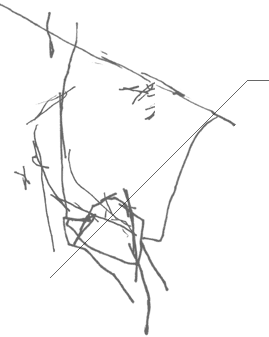Thursday, January 1, 2026 |
||

|

by Michael Goldberg
Monday August 6, 2001
The Dark Visions Of Raymond Pettibon
He first got our attention with startling flyers for Black Flag shows. These days he's seen in the galleries and museums.
|
|||
|
It's hard to watch "Ghost World," the film adaptation of artist Daniel Clowes' wonderful graphic novel of the same name, without thinking of another artist, one whose work doesn't lend itself so easily to being made into a film: Raymond Pettibon.
Pettibon's cynical, hard-boiled black-and-white drawings provided visuals for the raw, fast soundtrack of early-'80s punk — particularly the sound that roared from the abandoned warehouses and deadly suburbs of the real "ghost world," L.A. Pettibon, like Clowes, got his start in the least likely of forums. Pettibon was born in 1957, Clowes in 1961, and Pettibon's work certainly influenced Clowes. While Clowes, in the mid-to-late '80s, chose the underground comic book as his mode of entrée into the art world, Pettibon took to the streets. Out In The Streets In the late '70s and early '80s, telephone poles and sides of buildings in New York, Los Angeles and San Francisco (as well as other U.S. cities and towns) became like gallery walls for a new breed of visual artist. Day to day, you'd see the work of artists who created posters and flyers advertising punk shows by such artists as Crime, The Nuns, Negative Trend, Flipper, Black Flag and The Germs. By the early '80s, at least one of those artists, Pettibon, was also seeing his work featured on the covers of albums and singles by the band led by his half-brother, Greg Ginn: Black Flag. (He also drew the striking cover art for the Minutemen's album What Makes A Man Start Fires?) I was hooked from the first Pettibon image I saw. He combined a hard-edged style — he worked mostly with pen and black ink — with a dark sensibility and black humor. Some of his work shredded the hypocrisy of the peace/love/drugs/all-is-groovy sensibility of the San Francisco '60s counterculture. One piece showed a stoned, naked woman with hearts and flowers drawn on her body, falling to her death from a window, past a man on a scaffold who's painting Timothy Leary's "Turn On Tune In Drop Out" mantra on the side of the building. Another was simply the words "Helter Skelter," crudely lettered, and the caption: "Guns don't kill people. Songs do." Actually, I took Pettibon to be mocking the pseudo-hippies, the wannabes. The original '60s underground counterculture that appeared in 1965 grew out of the '50s Beat scene of San Francisco's North Beach. It was a small group of artists and writers and musicians who, back then, were able to live cheaply in certain areas of the city, and who were experimenting with both their art and the way they lived. First in San Francisco, and then in the Bay Area, word spread. Local media, then national media jumped on the scene, and soon youth across America and beyond began imitating the trappings — clothes, hair, drugs, "sexual freedom" — without understanding the philosophy that went with it. Then Charles Manson appeared, and in short order it was over. Bankrupt. Maintaining A 'Historical Distance' In a new coffee table book, "Raymond Pettibon" (Phaidon Press), which includes many examples of his art, Pettibon tells writer/interviewer Denis Cooper that he sees his work as commenting on aspects of society from a great distance. "I'm not a topical artist," he says. "I usually maintain a historical distance from my subjects." He notes that it was the late '70s and early '80s when he began commenting on the '50s and '60s in his work. Clowes, who continues to use the graphic novel as his canvas, is of course not the only artist to show Pettibon's influence. The poster artist Frank Kozik is also deeply indebted to him. Not only has Kozik at times lifted ideas directly from Pettibon (hippies, Charles Manson, Hitler and more), but he too got his start doing posters for club shows. Only Kozik started a decade after Pettibon, in the late '80s, doing flyers and posters for grunge and neo-punk shows. Though his work was first displayed in non-traditional contexts by fine-art standards, Pettibon eventually made his way into galleries and museums. Though some of his art causes him to be lumped with earlier underground comic-book artists such as R. Crumb — particularly the early-'80s drawings for flyers and album covers, as well as a series of booklets, sold by Ginn's SST Records, with titles such as "Tripping Corpse," "Asbestos" and "Just Happy to Be Working" — Pettibon disagrees. About his art, he says: "It's something completely different than either comics or literature." I think he's right. |
||||